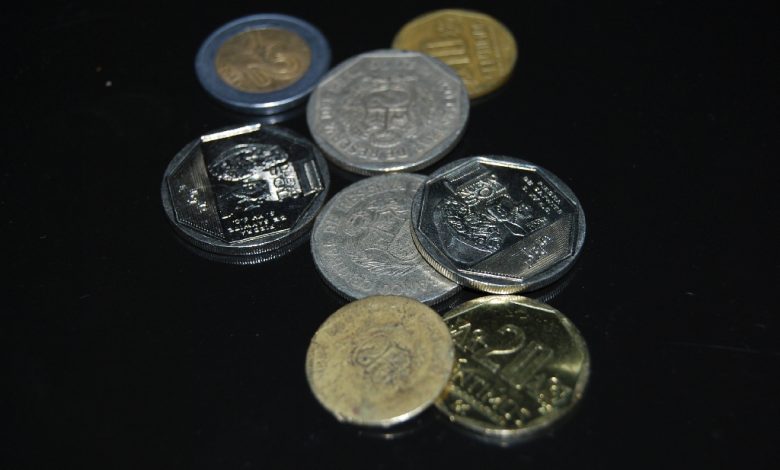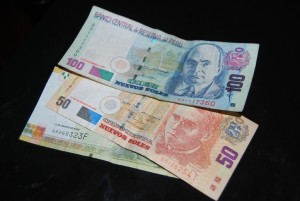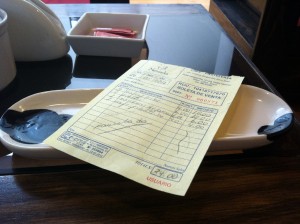Never Enough Change

Tourists in Cuzco face a perennial problem of change. You go to pay for something and offer one of the bills that commonly come from the ATM, a S/50 or S/100 note, and the merchant asks if you have something smaller or if you can pay with exact change. You poke through your pocket but all you have are those bills from your ATM run.There just never seems to be enough change and it impedes sales.
This morning at Starbucks, an international behemoth that sits above Cuzco’s main square and draws tourists like a vacuum:
A tall, athletic American with light brown hair and light brown eyes asks for a Grande Latte and then tenders a S/100 bill.
The young man working the cash register, who is tall for someone from Cuzco and normally has eyes that dance with humor says “do you have something smaller.”
The American looks at him confused and so the other young man working the bar, who has years of experience with Starbucks in Lima, the capital of Peru, where there are some thirty stores, jumped in because he feels more confident in his English.

“Do you have something smaller? We do not have change?”
The American, doubtfully, “You don’t have change?”
“No we do not have enough change. We can take credit cards though.”
“Well this is what I have” said the American with crisp irritation as he snapped his bill at them and turned and left.
If there is any place in Cuzco which you think would always be able to make change it would be one of the mutinationals that flock like birds drawn to the tourist sewn field of Cuzco’s Plaza de Armas. But not even they have enough change.
The clerks are always trying to chisel the clients into giving them coins or exact change. And, sometimes they lose sales, like this morning. As a result, old timers among travelers and almost all locals engage in the reciprocal of that game. When asked if they have coins or exact change they usually say “no” even when coins are chinking in their pockets.
Of course it is not only about coins, but increasingly about small bills, such as S/10 or S/20 notes.
A tug of war opens in which each side hoards their coins and small notes to try to force the other side to give in. At times it can be fun, but it is a constant irritant and something that just makes commerce tricky.

I was surprised this morning that Starbucks would not have enough small bills and coins to make change for a reasonable purchase and instead created a frustrated customer. So I spoke with the guys at the counter. Fortunately for me, they had a lull in the blusters of tourists that keep storming their counter.
It has always seemed to me that this was simply a matter of what I could call Peruvian culture (though it is much the same in neighboring countries). I have been traveling to Peru since 1974 and the tug of war just seems part of life.
But saying it is cultural is kind of a copout, and I should know better. People here are shrewd businesswomen and men. They would do whatever they could to make a sale. There must be a better explanation.
The guy at the counter, with a bit of a frown, since he figured I was criticizing them, said that despite Starbuck’s policies on customer service, they just could not get enough money out of the bank. He said each day they can only draw out two registers’ worth of change. The bank will not give them more, no matter how much they beg.
He said in Lima he saw other businesses do favors for the bankers, in a kind of soft bribe, to be able to get the change their business needed to thrive.
He feels frustrated because he and his colleagues are the front men who have no control over the situation but must constantly face the irritation of the tourists. The travelers do not understand since in most of their countries it is just expected businesses will start the day with enough cash on hand to make change, and if they run out that they can easily get more.
It would be interesting to speak with the banks to grasp the problem from their point of view, though I have not had that chance yet. It may well be that the general supply of currency is less than the economy needs. If nothing else, I expect that would keep the value of local currencies higher than they otherwise might be in the face of a flood of dollars from the more than a million tourists who come to Cuzco each year.

Soles, the Peruvian currency, are just scarce. While not so scarce as to create serious problems for the overall workings of commerce, they are in short enough supply to serve as a constant bother for travelers and locals and to create that seemingly endless tug of war over change.
Of course, another implication of this is that it will tend to make it easier for tourists who are part of packages where they almost never have to use local currency or be part of local markets and interactions, other than as mediated by their tour company. The shortage of change would seem to favor large monopolies.
It also, as a result, may well be a symptom of a strongly hierarchical and monopolized economy just like the pot-holed roads and all the humble houses rising up the hill sides of people struggling to survive in this place that generates so much wealth. Just as there is a shortage of coins, the means for money to flow to the ordinary Cusqueño are few, limited, and controlled.
But, those are just ideas. Wanting to check what the Starbucks employee had told me about banks, I asked other merchants.
“No, its not a problem with the banks” said a woman huddled behind her desk in an “internet”, an office with lots of computers lining the walls where people can come to access the internet. As she counted piles of coins in front of her to bag them and put them in a drawer of her desk, she said “the banks will give you as much as you want. You just have to ask for it, especially since it is money you are drawing from your own account. The people you are telling me about are just lazy.”
Yikes. My economic argument lies in smoking ruins on her wood floor as does the argument about culture. Instead, she proposes one of individual character and morality.
I still do not know why businesses seldom have enough change, or why they expect customers to always have correct change, but it just seems they do.
Still it is surprising to see Starbucks going that local. It has other customs, other policies, other values.
The American left Starbucks without his coffee and them without a sale. I do not know where he went. But if I had stayed around the counter I am sure I would have seen someone else face the same problem. So it is. Day in and day out. A struggle for change in Cuzco.





Value the knowledge, My partner and i ended up being stumped within this problem for months last but not least are solved.
Is it fine to insert part of this in my personal website if perhaps I post a reference point to this webpage?